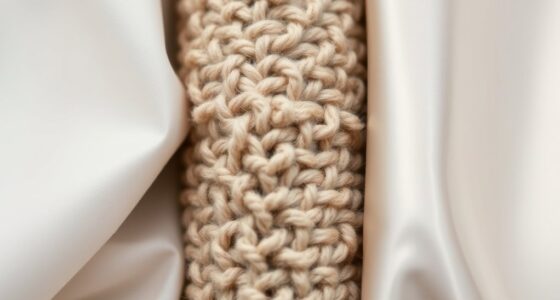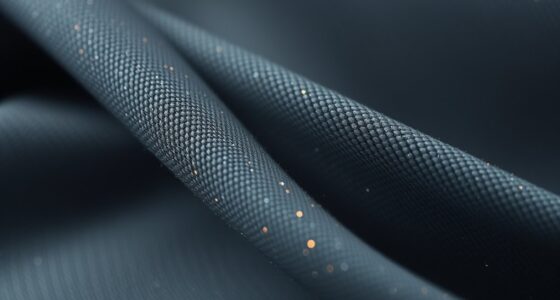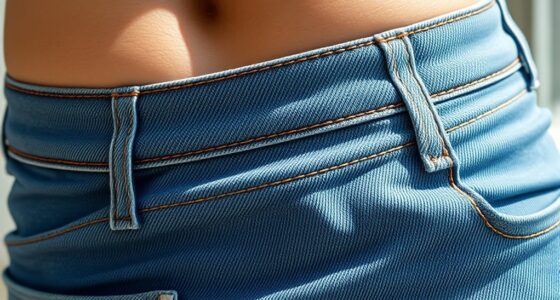Understanding denier helps you see how fabric thickness affects UV protection. Denier measures fiber weight and thickness, with higher denier fabrics being thicker and denser. Thicker fabrics usually block more UV rays, offering better protection, but may feel heavier or less breathable. Keep in mind that weave, material, and UV treatments also matter. If you want to learn more about choosing the right fabric for sun safety, keep exploring the details below.
Key Takeaways
- Higher denier indicates thicker fibers, which generally create a denser fabric barrier against UV rays.
- Thicker fabrics (higher denier) often provide better UV protection by reducing light penetration.
- Denier measures fiber thickness, influencing fabric density, weight, and its ability to block UV radiation effectively.
- Thicker fabrics tend to be more durable and resistant to UV damage, prolonging protective qualities.
- UV protection depends on fabric weave, material, and treatments, with denier being one of several influential factors.
What Is Denier and How Is It Measured?
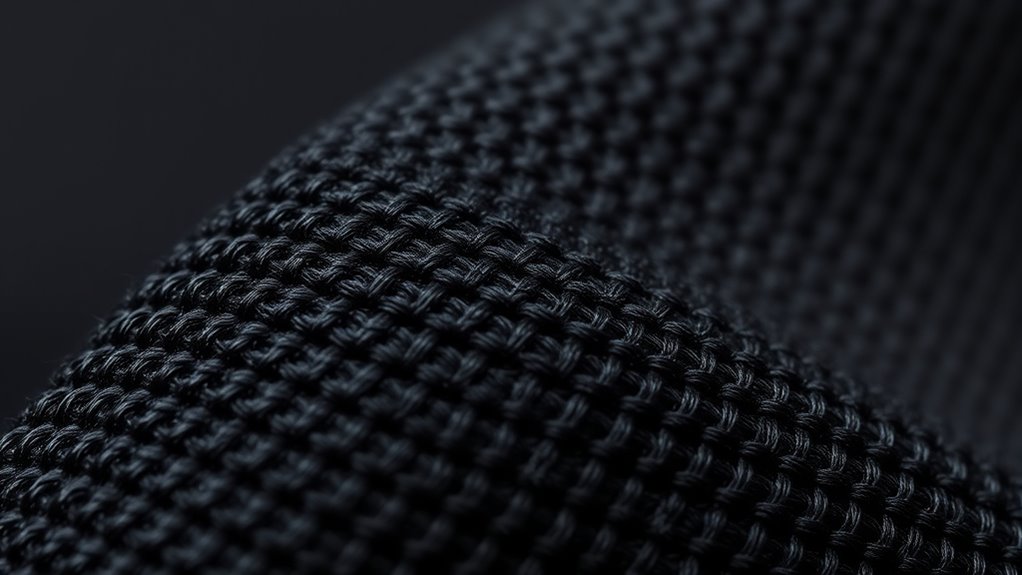
Ever wondered what denier really means? Denier measures the thickness of fibers in fabric, indicating how lightweight or heavy it is. It’s calculated by weighing 9,000 meters of fiber in grams. A higher denier means thicker fibers, which can affect fabric breathability and durability. Thicker fabrics often offer better UV protection but may reduce breathability, making them less comfortable in hot weather. Conversely, lower denier fabrics are lighter and more breathable, but they can be more prone to color fading over time. Understanding denier helps you choose fabrics suitable for your needs, balancing weight, durability, and comfort. It’s a vital factor in determining how well a fabric performs, especially when considering outdoor or UV-protective clothing. Additionally, fiber density impacts how tightly fibers are woven, influencing both UV protection and fabric strength.
The Relationship Between Denier and Fabric Thickness
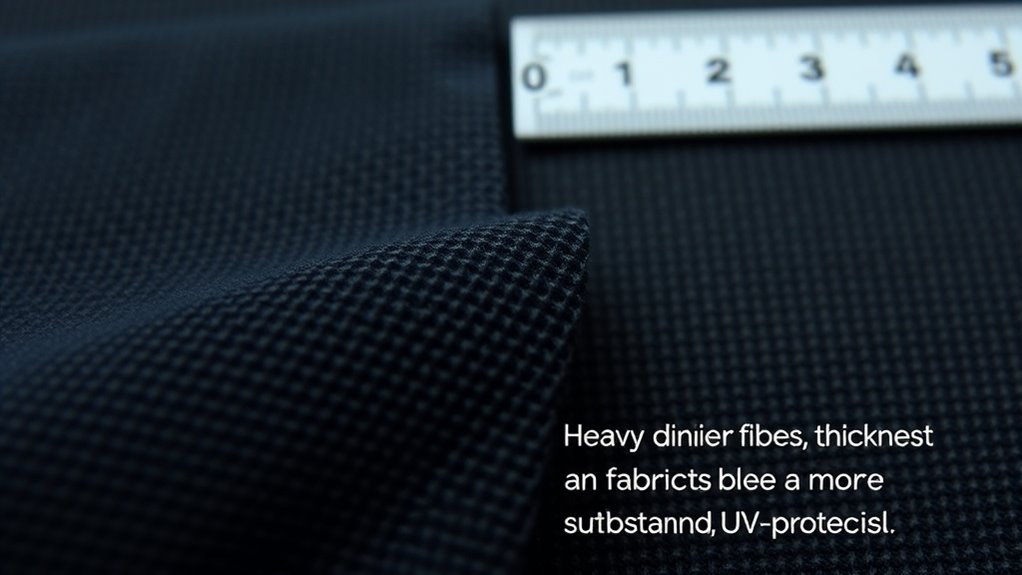
You’ll notice that higher denier fabrics tend to be thicker because of increased fiber density. Thicker fabrics can offer better UV protection but might feel heavier to wear. Understanding this relationship helps you choose the right fabric for your needs. Additionally, knowing the resources and tools available can assist you in selecting fabrics with optimal UV-blocking properties.
Denier and Fiber Density
How does the thickness of a fabric relate to its fiber density and denier? When fiber density increases, more fibers are packed into a given area, making the fabric thicker and heavier. Higher denier fabrics typically contain thicker or more numerous fibers, contributing to greater fabric weight. This increased fiber density results in a denser weave, which enhances durability and UV protection. As you compare fabrics, you’ll notice that a higher denier usually correlates with a more substantial feel and increased fabric weight. So, fiber density directly influences how thick a fabric feels and how much material is packed into it. Understanding this relationship helps you choose fabrics that balance comfort, protection, and durability effectively. Additionally, knowing how fiber density impacts fabric thickness can assist in selecting appropriate materials for specific applications like UV protection.
Thickness Impact on UV
When fabric thickness increases due to higher denier, it generally offers better protection against UV rays. Thicker fabrics block more sunlight, reducing UV penetration and safeguarding your skin. This increased thickness often enhances fabric durability, making it more resistant to wear and tear over time. Additionally, a higher denier can improve the aesthetic appeal by providing a denser, more substantial look and feel. However, keep in mind that thicker fabrics might feel heavier or less breathable, which could affect comfort. Balancing fabric durability, UV protection, and aesthetic appeal is key. Choosing the right denier depends on your specific needs—whether prioritizing long-lasting protection or a lighter, more breathable fabric. Ultimately, understanding how thickness impacts UV blocking helps you select the best fabric for your purpose. Fabric composition also plays a crucial role in UV protection, influencing how effectively the material shields against harmful rays.
How Denier Affects UV Blockage Capabilities
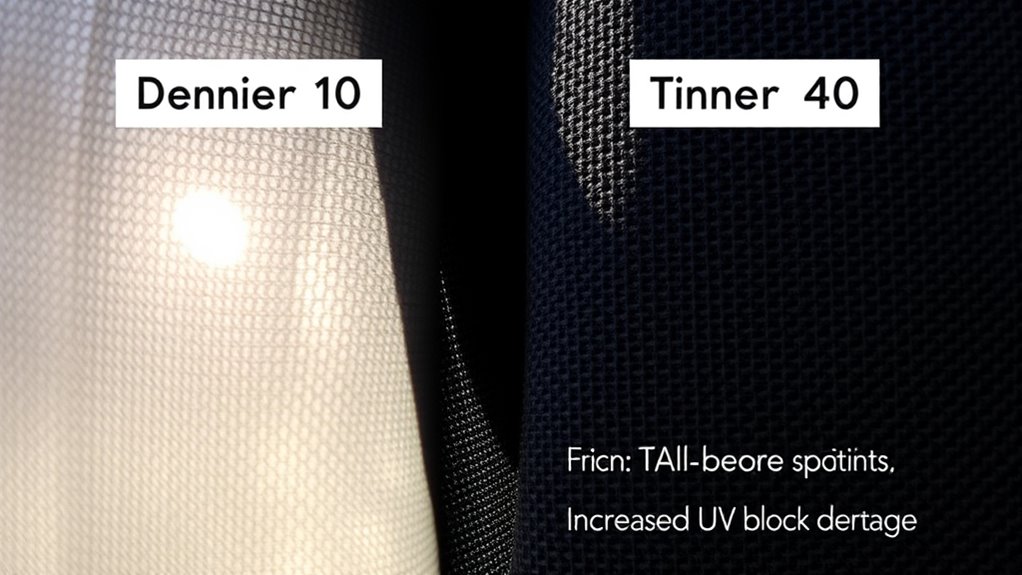
Higher denier ratings generally enhance UV blockage because thicker fibers create a more substantial barrier against ultraviolet rays. With increased denier, the fabric becomes denser, reducing the amount of UV light that penetrates through. Fabric color also influences UV resistance; darker shades tend to absorb more UV rays, working alongside higher denier fibers to improve protection. Conversely, lighter colors may allow more UV to pass through, even if the fabric has a high denier. So, when choosing clothing for sun protection, opt for higher denier fabrics in darker hues to maximize UV resistance. Keep in mind, the combination of thickness and color plays a key role in how effectively your clothing shields you from harmful rays. Additionally, understanding how fabric attention and limits can be leveraged helps in selecting the most effective UV-protective clothing.
Comparing Low and High Denier Fabrics for Sun Protection
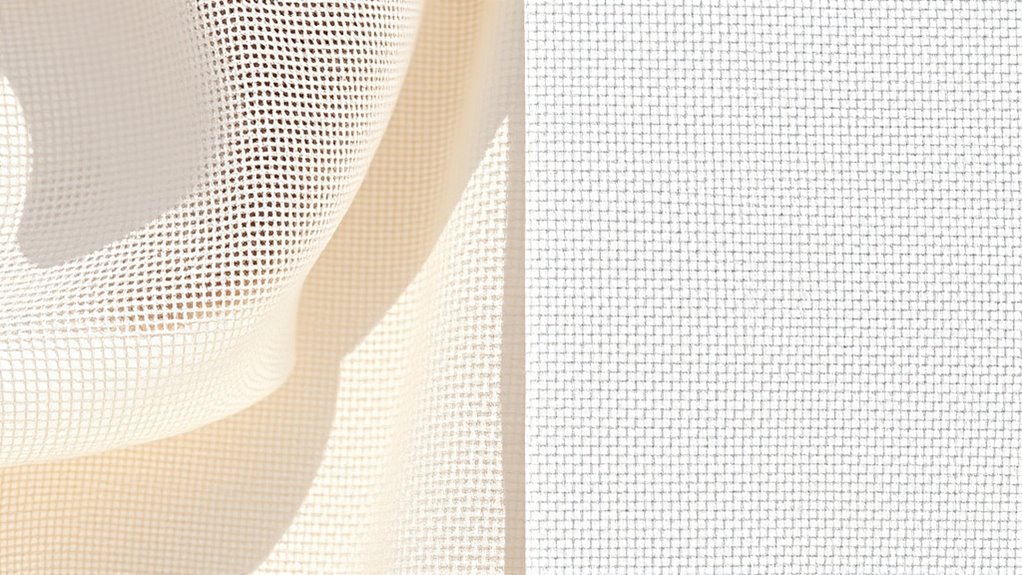
Low denier fabrics are lightweight and breathable, making them comfortable for everyday wear but often offering limited sun protection. These fabrics tend to feel softer against your skin, enhancing comfort and ease of movement. However, their thinner material usually provides less UV blocking compared to higher denier options. When it comes to color options, low denier fabrics typically come in a wider variety, allowing for more vibrant or pastel shades. Additionally, fabric denier influences not only UV protection but also the durability and longevity of the material. High denier fabrics are thicker and sturdier, offering better UV protection but may feel stiffer and less soft. They tend to have fewer color choices, often sticking to darker or more muted tones. Your choice depends on whether you prioritize softness and style or maximum UV shielding, but understanding the fabric’s denier helps you make an informed decision.
The Impact of Weave and Material Alongside Denier
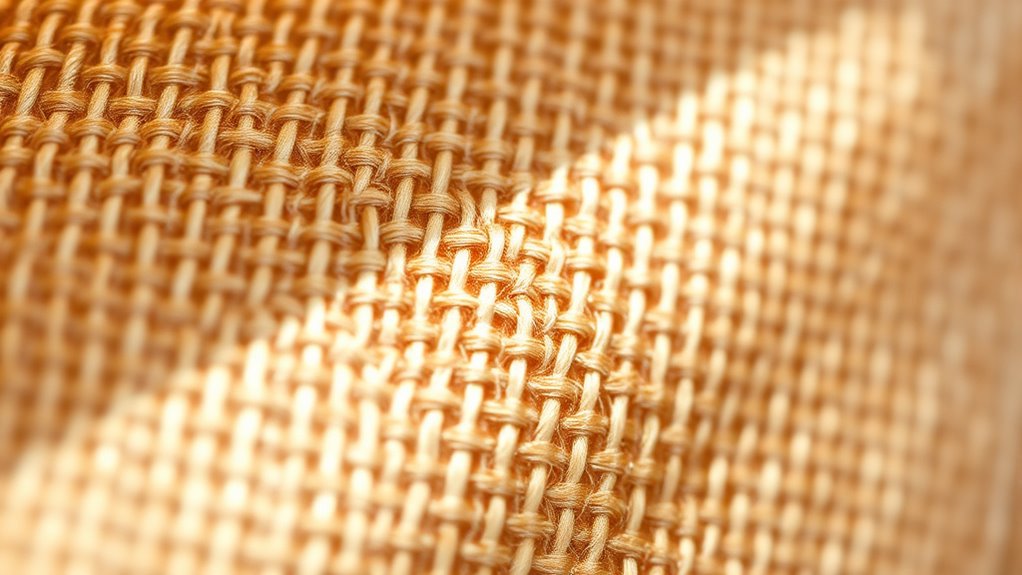
The weave and material of a fabric considerably influence its overall performance alongside denier. The type of weave pattern, whether tight or loose, determines how much UV radiation it blocks—tighter weaves generally offer better protection. Material blends also play an essential role; combining natural fibers with synthetic ones can enhance durability and UV resistance. For example, a polyester and cotton blend with a high denier may feel soft but might not provide optimal UV protection unless woven tightly. Conversely, a high-denier fabric with a specialized weave pattern can greatly improve UV blocking, regardless of the material. Additionally, the preppy aesthetic of fabrics can influence their style and desirability for sun protection clothing. Remember, understanding how weave patterns and material blends work together alongside denier helps you choose fabrics that deliver better sun protection without sacrificing comfort.
Choosing the Right Denier for Different Activities
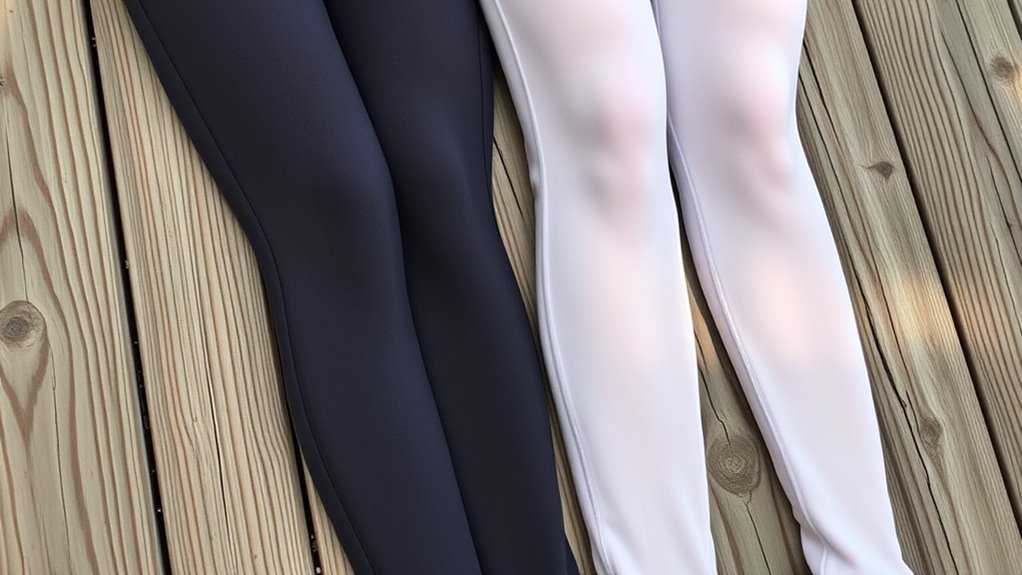
When selecting tights, consider your activity level to choose the right denier. Light activities like lounging work best with low denier, while outdoor sports need medium denier for durability. For heavy-duty tasks, opt for high denier to guarantee your tights hold up under pressure. Additionally, understanding self watering plant pots can help you maintain healthy plants by providing consistent moisture, similar to how selecting appropriate denier ensures your tights perform well during various activities.
Light Activities: Low Denier
Ever wondered which nylon denier is best suited for light activities like walking or lounging? Low denier fabrics, such as 10D or 15D, are ideal for these activities. They are lightweight fabrics that provide minimal coverage, ensuring comfort without feeling heavy or restrictive. These fabrics are perfect for casual wear, offering breathability and ease of movement. Choosing a low denier helps you stay cool while enjoying outdoor walks or relaxing at home. Keep in mind, lower denier fabrics often offer less durability but excel in comfort. For a stylish and functional home decor touch, incorporating aesthetic wall organization solutions can also enhance your living space. Here’s a quick guide to help you select the right lightweight fabric for your needs:
| Denier | Ideal Activity | Key Feature |
|---|---|---|
| 10D | Walking, lounging | Minimal coverage, lightest |
| 15D | Casual outings | Breathable, comfortable |
| 20D | Light outdoor activities | Flexible, soft |
| 25D | Relaxed wear | Easy to pack, airy |
| 30D | Light travel | Durable yet lightweight |
Outdoor Sports: Medium Denier
Looking for a fabric that balances durability and flexibility for outdoor sports? Medium denier fabrics are your best choice. They offer enough thickness to withstand active movement without sacrificing fabric softness, ensuring comfort during extended wear. This denier level provides good UV protection while remaining lightweight and breathable. You’ll notice that medium denier fabrics hold their shape well and resist tearing, perfect for activities like hiking, cycling, or running. Additionally, they can be suitable for integrating sound therapy to promote mental focus during outdoor activities. However, keep in mind that color fading can occur over time, especially with frequent exposure to sunlight and washing. To maintain your gear’s appearance and effectiveness, wash it gently and avoid harsh detergents. Overall, medium denier strikes a great balance, giving you durability and flexibility for most outdoor sports.
Heavy Duty Use: High Denier
For heavy-duty activities that demand maximum durability, selecting high denier fabrics is essential. These fabrics are thick and provide excellent resistance against tears and abrasions. While high denier materials might feel less soft initially, they often improve with wear, maintaining good fabric softness over time. They also excel at color retention, ensuring your gear stays vibrant despite frequent use and washing. Consider these points when choosing high denier fabrics:
- Superior durability for rugged environments
- Enhanced resistance to tearing and punctures
- Better color retention after multiple washes
- Slightly stiffer fabric feel initially, softening with use
- Ideal for workwear, outdoor gear, and protective clothing
Choosing the right high denier fabric ensures your gear withstands tough conditions while maintaining comfort and color integrity.
Common Misconceptions About Denier and Sun Safety
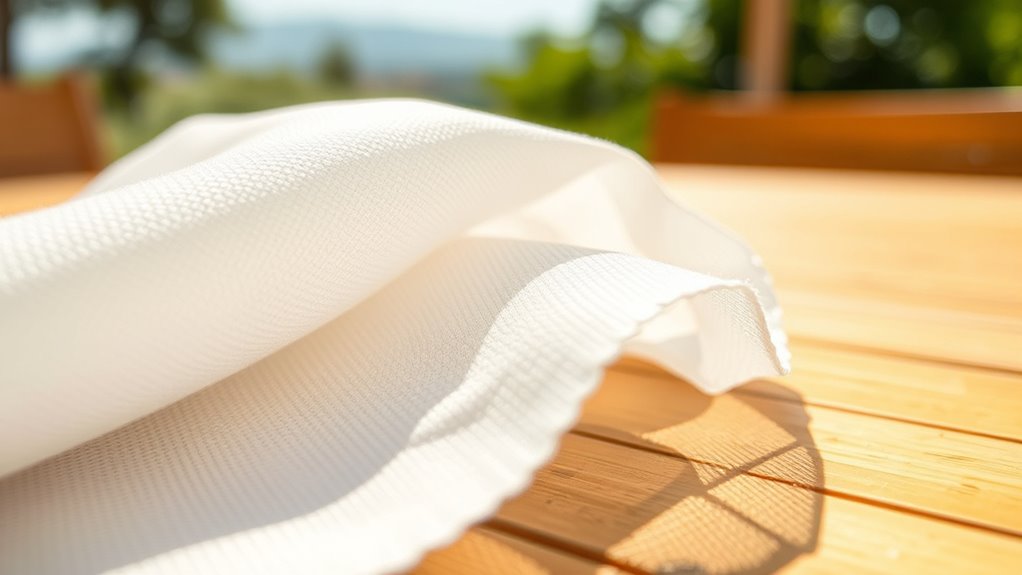
Many people believe that a higher denier number automatically means better sun protection, but that’s not always the case. Denier primarily measures fabric thickness, which can influence UV reflection, but it doesn’t guarantee superior UV protection. Thicker fabrics might reflect more sunlight, reducing UV exposure, but they can also trap heat and reduce fabric breathability, making them uncomfortable in hot weather. Conversely, lighter fabrics with lower denier can still offer effective sun protection if they’re tightly woven. It’s a common misconception that denier alone determines UV safety; fabric weave, material type, and UV coatings play essential roles. Remember, comfort and breathability are just as important as thickness when choosing sun-protective clothing.
Tips for Selecting Sun Protective Clothing Based on Denier
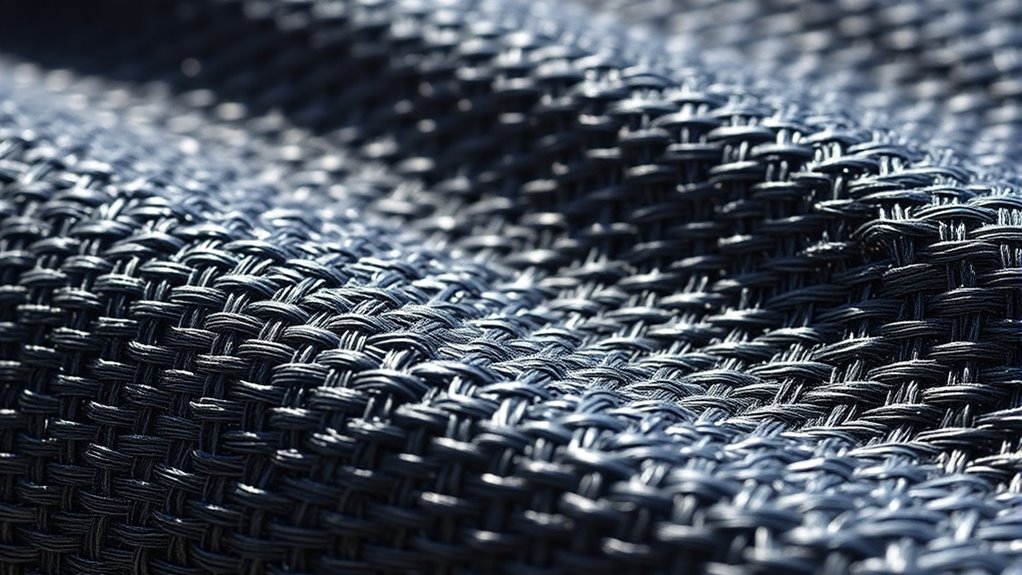
When choosing sun protective clothing, consider not just the denier number but also how the fabric’s weave, material, and UV treatments contribute to protection. A higher denier often means thicker fabric, but fabric breathability is equally important for comfort. Lighter colors tend to reflect UV rays more effectively, while darker shades absorb more heat, influencing your comfort. To make the best choice, look for clothing with tightly woven fabrics and UV-blocking finishes. Also, check if the fabric allows airflow to stay cool during outdoor activities. Keep in mind that a moderate denier combined with breathable, UV-treated fabric can offer both protection and comfort. Your goal is to find a balance between fabric thickness, breathability, and color influence for excellent sun safety.
Frequently Asked Questions
Can Lower Denier Fabrics Still Provide Effective UV Protection?
Lower denier fabrics can still offer effective UV protection, but it depends on fabric durability and material stretch. Thinner fabrics might feel lighter and more breathable, yet if they’re made from high-quality, tightly woven fibers, they can block UV rays effectively. Keep in mind, as fabric stretch increases, durability may decrease, so choosing a balance between thinness, durability, and stretch ensures maximum UV protection without sacrificing comfort.
Is Higher Denier Always Better for Sun Protection?
Higher denier isn’t always better for sun protection, as it mainly affects fabric durability and weight. While thicker fabrics can block more UV rays, they might sacrifice material flexibility and comfort, making them less suitable for everyday wear. You should consider factors like fabric weave and SPF rating along with denier to find a balance between protection, durability, and comfort that suits your needs.
How Does Denier Influence the Breathability of Fabric?
Ever wondered if denier affects how breathable your fabric is? It does, in fact. Higher denier fabrics tend to be thicker and less airy, which can trap heat and moisture. But lower denier fabrics usually feel lighter and promote better moisture wicking, keeping you cooler. So, if breathability matters, choose a fabric with a lower denier, as it offers a softer texture and enhanced airflow for your comfort.
Are There Specific Denier Ranges Recommended for Outdoor Sports?
For outdoor sports, you should choose a fabric with a denier range of 30 to 70. This range offers a good balance of fabric durability and flexibility, ensuring your clothing withstands active movement while remaining comfortable. Higher deniers increase material stiffness and durability, ideal for rugged use. Lower deniers keep fabrics lighter and more breathable, suitable for less intense activities. Select based on your activity’s demands for ideal performance.
Does Fabric Color Affect UV Protection Regardless of Denier?
You might notice fabric color affects UV protection, even if the denier stays the same. When fabric dyeing, darker colors tend to absorb more UV rays, offering better protection, while lighter shades may let more through. Over time, color fading can reduce this effect, exposing your skin. So, choosing the right color and understanding how dyeing impacts UV defense helps keep you safer during outdoor activities.
Conclusion
By understanding denier and its role in fabric thickness, you can make smarter choices for sun safety. Remember, sometimes the subtleties in fabric weight whisper stories of protection and comfort. By paying attention to denier, you’re gently guiding yourself toward clothing that shields you while allowing you to enjoy the sun’s warmth. Trust your instincts and select fabrics that softly embrace your skin, offering peace of mind with every sunlit moment.



